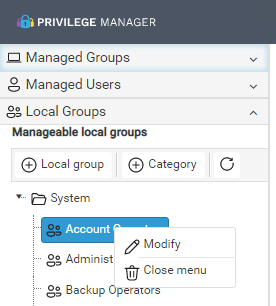Local groups are used to specify all local groups in your environment that you want to manage on your Privilege Manager Clients. There are predefined lists of well-known groups but you can create additional local groups that can then be managed by creating management rules for the group.

Local group functions:
Add Local group: Create a new local group that can then be managed by creating management rules for the user. See Create a Local Group.
Add Category: Create a new category to organize local groups, local users and workgroup computers. See Create a Category.
Modify: Modify an existing category by right-clicking a category folder. For more information, see Categories.
Modify an existing local group by right-clicking on the group. See Modify a Local Group.
Delete: Delete an existing category by right-clicking a category folder. For more information, see Categories.
Delete an existing local group by right-clicking on the group and confirming the deletion. All local user management rules are deleted if you delete the local group!
Privilege Manager cannot delete the built-in Administrator account from the local Administrators group, as Microsoft Windows prevents this action. To ensure that this account isn't used, you can disable it and randomize its password in Privilege Manager.
